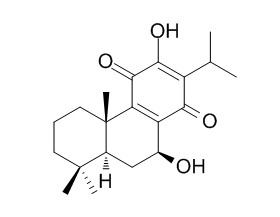Taxoquinone
Taxoquinone has strong antibacterial effect, it could be used as a promising antibacterial agent in food industry to inhibit the growth of certain important foodborne pathogens. It (100 ug/disc) displays potential anticandidal effect against Candia albicans.Taxoquinone has significant and concentration-dependent antioxidant and free radical scavenging activities, it could as a novel candidate in food and medicine industry as a natural alternative medicine to prevent diabetes mellitus type-2 related disorders and as a depigmentation agent.
Inquire / Order:
manager@chemfaces.com
Technical Inquiries:
service@chemfaces.com
Tel:
+86-27-84237783
Fax:
+86-27-84254680
Address:
1 Building, No. 83, CheCheng Rd., Wuhan Economic and Technological Development Zone, Wuhan, Hubei 430056, PRC
Providing storage is as stated on the product vial and the vial is kept tightly sealed, the product can be stored for up to
24 months(2-8C).
Wherever possible, you should prepare and use solutions on the same day. However, if you need to make up stock solutions in advance, we recommend that you store the solution as aliquots in tightly sealed vials at -20C. Generally, these will be useable for up to two weeks. Before use, and prior to opening the vial we recommend that you allow your product to equilibrate to room temperature for at least 1 hour.
Need more advice on solubility, usage and handling? Please email to: service@chemfaces.com
The packaging of the product may have turned upside down during transportation, resulting in the natural compounds adhering to the neck or cap of the vial. take the vial out of its packaging and gently shake to let the compounds fall to the bottom of the vial. for liquid products, centrifuge at 200-500 RPM to gather the liquid at the bottom of the vial. try to avoid loss or contamination during handling.
Oncol Lett.2020, 20(4):122.
Journal of Food Engineering2024, 379:112136.
J Mol Recognit.2020, 33(2):e2819
Exp Parasitol.2015, 153:160-4
Antioxidants (Basel).2021, 10(9):1487.
Food Chem.2024, 460(Pt 1):140472.
Biomed Pharmacother.2020, 128:110318.
Wageningen University & Research2018, January 2018
Analytical sci. & Tech2020, 33(5):224-231
Cell Mol Biol (Noisy-le-grand).2023, 69(15):167-173.
Related and Featured Products
South African Journal of Botany,2017,111:93-8.
Antioxidant and free radical scavenging activities of taxoquinone, a diterpenoid isolated from Metasequoia glyptostroboides[Reference:
WebLink]
METHODS AND RESULTS:
An abietane type diterpenoid Taxoquinone, isolated from ethyl acetate cone extract of Metasequoia glyptostroboides, was analyzed for its antioxidant efficacy as reducing power ability and its ability to scavenge free radicals such as 1,1-diphenyl-2-picryl hydrazyl (DPPH), nitric oxide, superoxide and hydroxyl radicals. As a result, Taxoquinone showed significant and concentration-dependent antioxidant and free radical scavenging activities of DPPH, nitric oxide, superoxide and hydroxyl free radicals by 78.83%, 72.42%, 72.99% and 85.04%, as compared to standard compounds ascorbic acid (81.69%, 74.62%, 73% and 73.79%) and α-tocopherol/butylated hydroxyanisole (84.09%, 78.61%, 74.45% and 70.02%), respectively.
CONCLUSIONS:
These findings justify the biological and traditional uses of M. glyptostroboides or its secondary metabolite Taxoquinone as confirmed by its promising antioxidant and free radical scavenging activities.
Bangladesh Journal of Pharmacology,2014,9(2):154-60.
Antimycotic potential of a diterpenoid taxoquinone against Candida species isolated from Metasequoia glyptostroboides[Reference:
WebLink]
The objective of this study was to confirm the antimycotic potential of a diterpenoid compound Taxoquinone, isolated from Metasequoia glyptostroboides against pathogenic isolates of Candida species.
METHODS AND RESULTS:
The Taxoquinone (100 μg/disc) displayed potential anticandidal effect against Candia albicans KBN06P00076, KBN06P00074, C. glabrata KBN06P00066, KBN06P00068, C. tropicalis KBN06P00682, KBN06P00058, C. parapsilosis KBN06P00060, KBN06P00055, and C. guilliermondii KBN06P00492 and KBN06P00867 as a diameter of zones of inhibition, found in the range of 10 ± 0.6 to 13 ± 1.1 mm. The minimum inhibitory and minimum fungicidal concentrations of Taxoquinone against the tested clinical isolates were found in the range of 125 to 500 and 125 to 1,000 μg/mL, respectively.
On the viable counts of the tested fungal isolates, the Taxoquinone evoked a remarkable anticandidal effect.
METHODS AND RESULTS:
Elaborative study of SEM revealed potential detrimental effect of Taxoquinone on the morphology of C. parapsilosis KBN06P00060 at MIC concentration. These findings confirmed therapeutic potential of Taxoquinone.
BMC Complement Altern Med. 2015 Mar 26;15:84.
α-Glucosidase and tyrosinase inhibitory effects of an abietane type diterpenoid taxoquinone from Metasequoia glyptostroboides[Pubmed:
25887244 ]
METHODS AND RESULTS:
In this study, a diterpenoid compound Taxoquinone, isolated from Metasequoia glyptostroboides was evaluated for its α-glucosidase and tyrosinase inhibitory efficacy in terms of its potent anti-diabetic and depigmentation potential, respectively.:As a result, Taxoquinone at the concentration range of 100-3,000 μg/mL and 200-1,000 μg/mL showed potent efficacy on inhibiting α-glucosidase and tyrosinase enzymes by 9.24-51.32% and 11.14-52.32%, respectively.
CONCLUSIONS:
The findings of this study clearly evident potent therapeutic efficacy of an abietane diterpenoid Taxoquinone isolated from M. glyptostroboides with a possibility for using it as a novel candidate in food and medicine industry as a natural alternative medicine to prevent diabetes mellitus type-2 related disorders and as a depigmentation agent.
Chemia Analityczna,2000,45(2):237-48.
Electrophoretic behaviour and quantitative analysis of active components 6,7-dehydroroyleanone and taxoquinone extracted from Salvia deserta Schang[Reference:
WebLink]
This communication demonstrates that micellar electrokinetic chromatography (MEKC) can be convenient for the determination of minor active components 6,7-dehydro-royleanone and Taxoquinone in the extract of the traditional Chinese medicinal herb.
METHODS AND RESULTS:
6,7-Dehydroroyleanone and Taxoquinone can be monitored selectively and sensitively at 254 nm within 8 min in the plant extract, using alfa-cyclodextrin (alfa-CD) as a MEKC modified. The concentration range was 5-500 ug ml-1 for 6,7-dehydroroyleanone and 2.5-750 ug ml-1 for Taxoquinone with good linear correlation coefficients 0.9997 and 0.9989, respectively. It was found that 68.2 ug of 6,7-dehydroroyleanone and 12.5 ug of Taxoquinone were contained in 1 g of Salvia deserta Schang roots.
CONCLUSIONS:
The inclusion of 6,7-dehydroroyleanone and Taxoquinone with alfa-CD in capillary zone electrophoresis (CZE) was studied, and the inclusion constant logKCD were 4.1 and 3.2 for 6,7-dehydroroyleanone and Taxoquinone, respectively.



